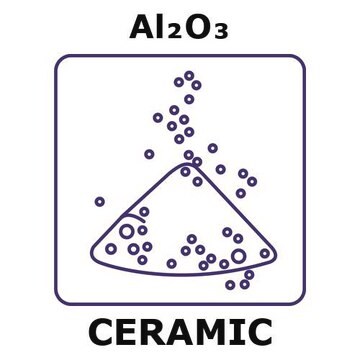702129
Aluminum oxide
nanoparticles, <50 nm particle size (DLS), 20 wt. % in isopropanol
Sinonimo/i:
Alumina
About This Item
Prodotti consigliati
Forma fisica
dispersion
nanoparticles
Livello qualitativo
Concentrazione
20 wt. % in isopropanol
Dimensione particelle
<50 nm (DLS)
pH
8-10
Densità
0.79 g/cm3 at 25 °C
Stringa SMILE
O=[Al]O[Al]=O
InChI
1S/2Al.3O
TWNQGVIAIRXVLR-UHFFFAOYSA-N
Cerchi prodotti simili? Visita Guida al confronto tra prodotti
Descrizione generale
Applicazioni
- Elemental analysis of levitated solid samples by microwave-assisted laser induced breakdown spectroscopy.: This study explores the application of aluminium oxide in enhancing the elemental analysis capabilities of laser induced breakdown spectroscopy, providing a novel approach for high precision chemical analysis in analytical chemistry (Alamri AM et al., 2024).
- An ab initio molecular dynamics investigation of the behaviour of amorphous substances in anodic aluminium oxide under electric field.: This research presents a molecular-level understanding of how amorphous substances behave within anodic aluminium oxide structures when subjected to an electric field, offering insights into the material′s stability and reactivity (An Z et al., 2024).
- Alternative nano-lithographic tools for shell-isolated nanoparticle enhanced Raman spectroscopy substrates.: The article discusses the utilization of aluminium oxide in the development of advanced nano-lithographic tools, significantly enhancing the performance of Raman spectroscopy for chemical detection and analysis (Srivastava K et al., 2024).
- Unexpected early loosening of rectangular straight femoral Zweymüller stems with an alumina-reduced surface after total hip arthroplasty-a prospective, double-blind, randomized controlled trial.: This study examines the clinical implications of using aluminium oxide in prosthetic implants, specifically its effect on the longevity and stability of femoral stems in hip arthroplasty (Moret CS et al., 2024).
- Green Synthesis of Aluminum Oxide Nanoparticles Using Clerodendrum phlomidis and Their Antibacterial, Anti-inflammatory, and Antioxidant Activities.: Investigates the biogenic synthesis of aluminium oxide nanoparticles, highlighting their potential in biomedical applications due to their antibacterial, anti-inflammatory, and antioxidant properties (Thanaraj S et al., 2024).
Avvertenze
Danger
Indicazioni di pericolo
Consigli di prudenza
Classi di pericolo
Eye Irrit. 2 - Flam. Liq. 2 - STOT SE 3
Organi bersaglio
Central nervous system
Codice della classe di stoccaggio
3 - Flammable liquids
Classe di pericolosità dell'acqua (WGK)
WGK 1
Punto d’infiammabilità (°F)
53.6 °F - closed cup
Punto d’infiammabilità (°C)
12 °C - closed cup
Dispositivi di protezione individuale
Eyeshields, Faceshields, Gloves, type ABEK (EN14387) respirator filter
Scegli una delle versioni più recenti:
Possiedi già questo prodotto?
I documenti relativi ai prodotti acquistati recentemente sono disponibili nell’Archivio dei documenti.
I clienti hanno visto anche
Articoli
Hydrogen is one of the most important resources in providing food, fuel, and chemical products for our everyday life. Sustainable catalytic hydrogen production from bioethanol has gained significant attention in recent years due to globally diminishing fossil fuel supplies, which have necessitated the search for new chemical feedstocks.
Among various ceramics, one-dimensional (1-D) piezoelectric ceramics have attracted significant scientific attention for use in energy harvesting.
Electronically, it behaves as a wide band gap (3.2 eV) semiconductor and exhibits memristor properties.2 Optically, TiO2 has high opacity with a very high refractive index3 (>2.4), and it exhibits strong absorbance in the UV range.
Advanced Inorganic Materials for Solid State Lighting
Il team dei nostri ricercatori vanta grande esperienza in tutte le aree della ricerca quali Life Science, scienza dei materiali, sintesi chimica, cromatografia, discipline analitiche, ecc..
Contatta l'Assistenza Tecnica.


![[6,6]-Phenyl C61 butyric acid methyl ester ≥99%](/deepweb/assets/sigmaaldrich/product/structures/359/221/d990c746-0960-4c69-bf76-fe09b193824d/640/d990c746-0960-4c69-bf76-fe09b193824d.png)



